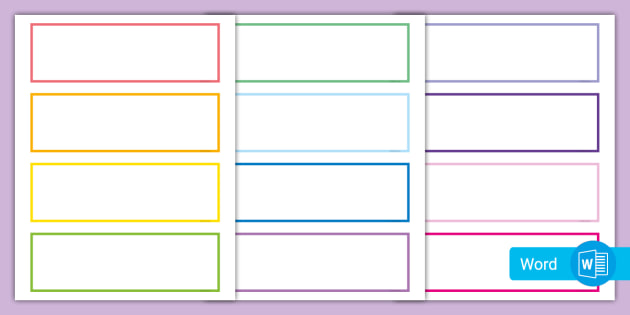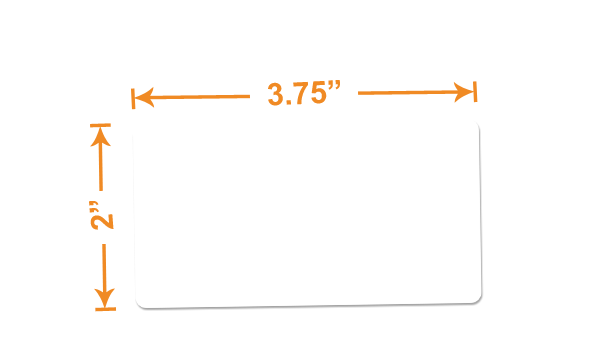Recognizing Just How Blank Labels Work to Improve Your Labeling Experience
Comprehending the mechanics of blank labels is vital for enhancing your labeling practices across numerous contexts. To totally realize exactly how these labels can transform your procedures, one should take into consideration the various types readily available and the myriad ways they can be tailored to fit particular demands.

Advantages of Utilizing Blank Labels
Blank labels offer a flexible solution for numerous labeling demands, making them vital in both individual and expert settings. Their versatility allows customers to produce customized labels customized to certain requirements, improving organizational efficiency. Whether utilized in office, retail environments, or industrial applications, blank labels promote the recognition and classification of products, documents, and individual things.
One considerable benefit of blank labels is their cost-effectiveness. By allowing users to print only the labels they require, waste is reduced, and inventory administration comes to be extra manageable. In addition, blank labels work with various printing techniques, including inkjet and printer, making them available for different users.

Furthermore, using blank labels streamlines the procedure of updating details, as users can conveniently print brand-new labels to replace obsolete ones, guaranteeing that all products and records are precisely identified. Generally, blank labels provide a useful and efficient labeling remedy for varied applications.
Sorts Of Blank Labels Available
What alternatives are available when it pertains to blank labels? Blank labels can be found in a variety of kinds, each matched for different applications and choices. One of the most common kinds include paper labels, which are flexible and affordable, making them optimal for day-to-day use. They are offered in numerous finishes, such as matte and glossy, allowing for visual adaptability.
Another prominent alternative is synthetic labels, commonly made from materials like polyester or plastic. These labels are recognized for their sturdiness and resistance to water, chemicals, and tearing, making them appropriate for harsh settings. They are frequently utilized in industrial setups or for labeling items that may be exposed to wetness.
Furthermore, there are thermal transfer labels, which need a printer that makes use of warmth to transfer ink onto the tag surface. These labels are favored for their premium print and long life.
Last but not least, specialized labels satisfy particular demands, such as detachable labels for short-lived usage or high-temperature labels for extreme problems. Understanding these alternatives permits users to pick one of the most suitable blank tag for their special labeling demands.
Customization Options for Labels
A resource wide array top article of customization choices is offered for labels, permitting individuals to customize them to specific needs and branding requirements. Individuals can select from different dimensions, forms, and products to guarantee that the labels effectively fit their desired purpose. Typical products consist of paper, polyester, and vinyl, each providing various levels of durability and visual charm.
Shade choices play an important function in personalization, making it possible for brands to preserve consistency with their corporate identification. Individuals can select from a range of colors or perhaps choose for custom-made printing to match details branding aspects. Furthermore, labels can be printed with distinct styles, logos, and text, enhancing brand recognition and aesthetic influence.
Another important aspect is the selection of adhesive. Tags can be designed with irreversible, removable, or repositionable adhesives, depending on the application requirements. This versatility permits effective labeling solutions throughout numerous environments, from retail to industrial settings.

Tips for Effective Labeling
Reliable labeling goes beyond customization; it additionally involves calculated considerations that enhance performance and communication. To attain effective labeling, begin by clearly defining the function web of each tag.
Following, prioritize presence by picking suitable shades and fonts. High comparison in between text and history enhances readability, while bigger fonts help with quick identification. In addition, make sure that labels are placed in a regular and logical way, making it less complicated for users to locate and translate information.
Think about the toughness of labels. Choose materials suited for the particular setting where the labels will certainly be made use of, whether it be inside your home or outdoors. Water-proof or tear-resistant choices may be needed depending upon the context.
Last but not least, consistently evaluation and update your labels to mirror any adjustments in details or usage. This proactive approach not only keeps quality yet additionally stays clear of confusion with time. By adhering to these pointers, you can make best use of the efficiency of your labeling efforts, guaranteeing they serve their intended purpose efficiently.
Applications of Blank Labels
Blank labels provide various applications throughout different markets, making them a vital tool for organization and communication. These versatile labels are typically made use of in storage facilities for stock administration, allowing organizations to conveniently recognize and track items. By using blank labels to storage containers, racks, or pallets, firms can improve their procedures and lower the possibility of errors.
In the medical care sector, blank labels play an essential function in classifying medicines and clinical supplies, guaranteeing proper identification and usage. Customizable labels can include necessary info such as dose, expiry days, and patient details, improving security and conformity.
In retail, blank labels aid in pricing items, providing promotions, or classifying rack places, which inevitably improves the client experience. They enable fast updates to rates or product details without the demand for pre-printed labels.
Additionally, blank labels are helpful for individual usage, such as organizing office, crafting, or classifying food containers. Their adaptability permits individuals to create tailored solutions that satisfy details requirements. Generally, the applications of blank labels are substantial, emphasizing their relevance in promoting performance and quality in various setups.
Conclusion
To conclude, blank labels present a flexible and effective option for different labeling needs. Their versatility in size, form, and material enables for customized applications throughout various atmospheres. By leveraging personalization options and reliable labeling strategies, companies can boost quality and interaction (Blank Labels). Inevitably, the assimilation of blank labels into operational processes adds to enhanced effectiveness, making them an indispensable resource for both personal and expert usage.